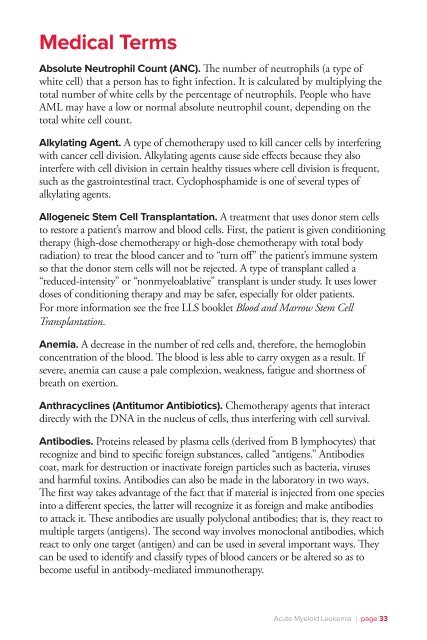Acute Myeloid Leukemia - The Leukemia & Lymphoma Society
Acute Myeloid Leukemia - The Leukemia & Lymphoma Society
Acute Myeloid Leukemia - The Leukemia & Lymphoma Society
- No tags were found...
You also want an ePaper? Increase the reach of your titles
YUMPU automatically turns print PDFs into web optimized ePapers that Google loves.
Medical TermsAbsolute Neutrophil Count (ANC). <strong>The</strong> number of neutrophils (a type ofwhite cell) that a person has to fight infection. It is calculated by multiplying thetotal number of white cells by the percentage of neutrophils. People who haveAML may have a low or normal absolute neutrophil count, depending on thetotal white cell count.Alkylating Agent. A type of chemotherapy used to kill cancer cells by interferingwith cancer cell division. Alkylating agents cause side effects because they alsointerfere with cell division in certain healthy tissues where cell division is frequent,such as the gastrointestinal tract. Cyclophosphamide is one of several types ofalkylating agents.Allogeneic Stem Cell Transplantation. A treatment that uses donor stem cellsto restore a patient’s marrow and blood cells. First, the patient is given conditioningtherapy (high-dose chemotherapy or high-dose chemotherapy with total bodyradiation) to treat the blood cancer and to “turn off” the patient’s immune systemso that the donor stem cells will not be rejected. A type of transplant called a“reduced-intensity” or “nonmyeloablative” transplant is under study. It uses lowerdoses of conditioning therapy and may be safer, especially for older patients.For more information see the free LLS booklet Blood and Marrow Stem CellTransplantation.Anemia. A decrease in the number of red cells and, therefore, the hemoglobinconcentration of the blood. <strong>The</strong> blood is less able to carry oxygen as a result. Ifsevere, anemia can cause a pale complexion, weakness, fatigue and shortness ofbreath on exertion.Anthracyclines (Antitumor Antibiotics). Chemotherapy agents that interactdirectly with the DNA in the nucleus of cells, thus interfering with cell survival.Antibodies. Proteins released by plasma cells (derived from B lymphocytes) thatrecognize and bind to specific foreign substances, called “antigens.” Antibodiescoat, mark for destruction or inactivate foreign particles such as bacteria, virusesand harmful toxins. Antibodies can also be made in the laboratory in two ways.<strong>The</strong> first way takes advantage of the fact that if material is injected from one speciesinto a different species, the latter will recognize it as foreign and make antibodiesto attack it. <strong>The</strong>se antibodies are usually polyclonal antibodies; that is, they react tomultiple targets (antigens). <strong>The</strong> second way involves monoclonal antibodies, whichreact to only one target (antigen) and can be used in several important ways. <strong>The</strong>ycan be used to identify and classify types of blood cancers or be altered so as tobecome useful in antibody-mediated immunotherapy.<strong>Acute</strong> <strong>Myeloid</strong> <strong>Leukemia</strong> I page 33
















